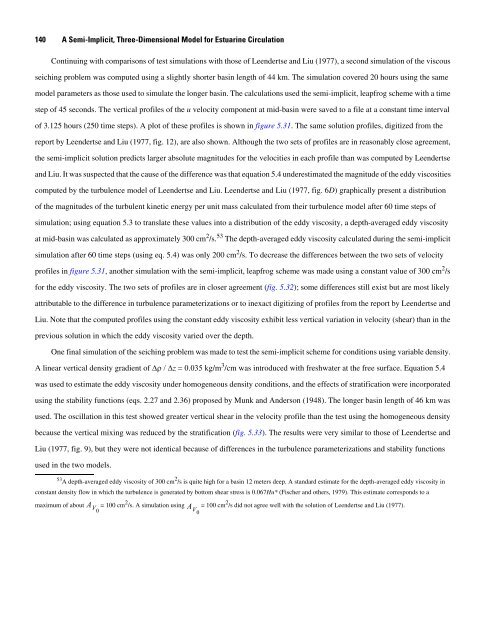A Semi-Implicit, Three-Dimensional Model for Estuarine ... - USGS
A Semi-Implicit, Three-Dimensional Model for Estuarine ... - USGS
A Semi-Implicit, Three-Dimensional Model for Estuarine ... - USGS
Create successful ePaper yourself
Turn your PDF publications into a flip-book with our unique Google optimized e-Paper software.
140 A <strong>Semi</strong>-<strong>Implicit</strong>, <strong>Three</strong>-<strong>Dimensional</strong> <strong>Model</strong> <strong>for</strong> <strong>Estuarine</strong> Circulation<br />
Continuing with comparisons of test simulations with those of Leendertse and Liu (1977), a second simulation of the viscous<br />
seiching problem was computed using a slightly shorter basin length of 44 km. The simulation covered 20 hours using the same<br />
model parameters as those used to simulate the longer basin. The calculations used the semi-implicit, leapfrog scheme with a time<br />
step of 45 seconds. The vertical profiles of the u velocity component at mid-basin were saved to a file at a constant time interval<br />
of 3.125 hours (250 time steps). A plot of these profiles is shown in figure 5.31. The same solution profiles, digitized from the<br />
report by Leendertse and Liu (1977, fig. 12), are also shown. Although the two sets of profiles are in reasonably close agreement,<br />
the semi-implicit solution predicts larger absolute magnitudes <strong>for</strong> the velocities in each profile than was computed by Leendertse<br />
and Liu. It was suspected that the cause of the difference was that equation 5.4 underestimated the magnitude of the eddy viscosities<br />
computed by the turbulence model of Leendertse and Liu. Leendertse and Liu (1977, fig. 6D) graphically present a distribution<br />
of the magnitudes of the turbulent kinetic energy per unit mass calculated from their turbulence model after 60 time steps of<br />
simulation; using equation 5.3 to translate these values into a distribution of the eddy viscosity, a depth-averaged eddy viscosity<br />
at mid-basin was calculated as approximately 300 cm 2 /s. 53 The depth-averaged eddy viscosity calculated during the semi-implicit<br />
simulation after 60 time steps (using eq. 5.4) was only 200 cm 2 /s. To decrease the differences between the two sets of velocity<br />
profiles in figure 5.31, another simulation with the semi-implicit, leapfrog scheme was made using a constant value of 300 cm 2 /s<br />
<strong>for</strong> the eddy viscosity. The two sets of profiles are in closer agreement (fig. 5.32); some differences still exist but are most likely<br />
attributable to the difference in turbulence parameterizations or to inexact digitizing of profiles from the report by Leendertse and<br />
Liu. Note that the computed profiles using the constant eddy viscosity exhibit less vertical variation in velocity (shear) than in the<br />
previous solution in which the eddy viscosity varied over the depth.<br />
One final simulation of the seiching problem was made to test the semi-implicit scheme <strong>for</strong> conditions using variable density.<br />
A linear vertical density gradient of Δρ / Δz = 0.035 kg/m 3 /cm was introduced with freshwater at the free surface. Equation 5.4<br />
was used to estimate the eddy viscosity under homogeneous density conditions, and the effects of stratification were incorporated<br />
using the stability functions (eqs. 2.27 and 2.36) proposed by Munk and Anderson (1948). The longer basin length of 46 km was<br />
used. The oscillation in this test showed greater vertical shear in the velocity profile than the test using the homogeneous density<br />
because the vertical mixing was reduced by the stratification (fig. 5.33). The results were very similar to those of Leendertse and<br />
Liu (1977, fig. 9), but they were not identical because of differences in the turbulence parameterizations and stability functions<br />
used in the two models.<br />
53 A depth-averaged eddy viscosity of 300 cm 2 /s is quite high <strong>for</strong> a basin 12 meters deep. A standard estimate <strong>for</strong> the depth-averaged eddy viscosity in<br />
constant density flow in which the turbulence is generated by bottom shear stress is 0.067Hu* (Fischer and others, 1979). This estimate corresponds to a<br />
maximum of about AV0 = 100 cm 2 /s. A simulation using A = 100 cm<br />
V0<br />
2 /s did not agree well with the solution of Leendertse and Liu (1977).

















